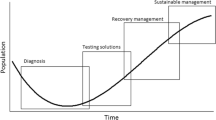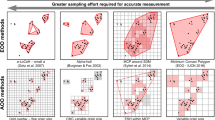Iterative reserve selection algorithms were applied to two mammal databases, generalized to sixteenth degree grid squares, for the Transvaal region of South Africa. Based on primary point data, 24 grid squares are required to represent all species at least once, while only 13 grid squares are required when based on distribution map data; only two of these grid squares are common to both analyses. As the number of representations per species is increased from one to five, the number of selected grid squares increased to 86 and 71 or 72 respectively, with only 17 of these common to both analyses. These differences in the selection of sites are further reflected in the degree of congruence between selected grid squares and existing conservation areas which is on average 63.3% for grid squares selected from the primary database and only 42.5% for those selected from the distribution map database. These results emphasize the importance of quality data input when evaluating regional reserve networks. Highly generalized distribution map data sets, on the one hand, are extrapolations of limited data sets and contain non-quantifiable levels of false-positives which could have significant implications if used for establishing regional reserve networks. On the other hand, although there are problems associated with the establishment of primary diversity databases, namely data currency and uneven and non-random sampling (leading to false negatives), they remain our most reliable option for assigning conservation value.
Similar content being viewed by others
References
Austin M.P. and Margules C.R. (1986) Assessing representativeness. In Wildlife Conservation Evaluation (M.B. Usher, ed.) pp. 45–67. London: Chapman and Hall.
Bedward M., Pressey R.L. and Keith D.A. (1992a) A new approach for selecting fully representative reserve networks: addressing efficiency, reserve design and land suitability with an iterative analysis. Biol. Conserv. 62, 115–25.
Bedward M., Keith D.A. and Pressey R.L. (1992b) Homogeneity analysis: assessing the utility of classifications and maps of natural resources. Austr. J. Ecol. 17, 133–9.
Brown J.H. (1984) On the relationship between abundance and distribution of species. Am. Nat. 124, 255–79.
Burgman M.A. (1988) Spatial analysis of vegetation patterns in south Western Australia: implications for reserve design. Austr. J. Ecol. 13, 415–29.
Burkey T.V. (1989) Extinction in nature reserves: the effect of fragmentation and the importance of migration between reserve fragments. Oikos 55, 75–81.
Cocks K.D. and Baird I.A. (1989) Using mathematical programming to address the multiple reserve selection problem: an example from the Eyre Peninsula, South Australia. Biol. Conserv. 49, 113–30.
Crowe T.M. (1990) A quantitative analysis of patterns of distribution, species richness and endemism in southern African vertebrates. In Vertebrates in the Tropics (G. Peters and R. Hutterer, eds) pp. 145–60. Bonn: Museum Alexander Koenig.
Gaston K.J. and Lawton J.H. (1990) Effects of scale and habitat on the relationship between regional distribution and local abundance. Oikos 58, 329–35.
Gaston K.J. and Hudson E. (1994) Regional patterns of diversity and estimates of global insect species richness. Biodiv. Conserv. 3, 493–500.
Gotmark F., Ahlund M. and Eriksson M.O.G. (1986) Are indices reliable for assessing conservation value of natural areas? An avian case study. Biol. Conserv. 38, 55–73.
IUCN (1980) World Conservation Strategy. Gland, Switzerland: IUCN.
Kirkpatrick J.B. (1983) An iterative method for establishing priorities for the selection of nature reserves: an example from Tasmania. Biol. Conserv. 25, 127–34.
Lawton J.H. (1993) Range, population abundance and conservation. TREE 8, 409–13.
Lombard, A.T., Nicholls, A.O. and August, P.V. (1995) Where should nature reserves be located in South Africa? A snake's perspective. Cons. Biol.
Margules C.R. and Usher M.B. (1981) Criteria used in assessing wildlife conservation potential: a review. Biol. Conserv. 21, 79–109.
Margules C.R. and Nicholls A.O. (1987) Assessing the conservation value of remnant habitat ‘islands’: mallee patches on the Western Eyre Peninsula, South Australia. In Nature Conservation: The Role of Remnants of Native Vegetation (D.A. Saunders, G.W. Arnold, A.A. Burbidge and A.J.M. Hopkins, eds) pp. 89–102. Canberra: Surrey Beatty and Sons.
Margules C.R., Nicholls A.O. and Pressey R.L. (1988) Selecting networks of reserves to maximize biological diversity. Biol. Conserv. 43, 63–76.
Margules C.R. (1989) Introduction to some Australian developments in conservation evaluation. Biol. Conserv. 50, 1–11.
Margules C.R. and Stein J.L. (1989) Patterns in the distribution of species and the selection of nature reserves: an example from the Eucalyptus forests in south-eastern New South Wales. Biol. Conserv. 50, 219–38.
Margules C.R., Pressey R.L. and Nicholls A.O. (1991) Selecting nature reserves. In Nature Conservation: Cost Effective Biological Surveys and Data Analysis (C.R. Margules and M.P. Austin, eds) pp. 90–7. Australia: CSIRO.
Margules C.R., Cresswell I.D. and Nicholls A.O. (1994) A scientific basis for establishing networks of protected areas. In Systematics and Conservation Evaluation (P.L. Forey, C.J. Humphries and R.I. Vane-Wright, eds) pp. 327–50. Oxford: Oxford University Press.
Margules, C.R. and Nicholls, A.O. (in press) Where should nature reserves be located? In Conservation Biology in Australia and Oceania (C. Moritz, J. Kikkawa and D. Doley, eds) New South Wales: Surrey Beatty and Sons, Chipping Norton.
McKenzie L., Belbin L., Margules C.R. and Keighery G.J. (1989) Selecting representative reserve systems in remote areas: a case study in the Nullarbor region, Australia. Biol. Conserv. 50, 239–61.
McNeely J.A. (1994) Protected areas for the 21st century: working to provide benefits to society. Biodiv. Conserv. 3, 390–405.
Nicholls A.O. and Margules C.R. (1993) An upgraded reserve selection algorithm. Biol. Conserv. 64, 165–9.
Pressey R.L. and Nicholls A.O. (1989) Efficiency in conservation evaluation: scoring versus iterative processes. Biol. Conserv. 50, 199–218.
Pressey R.L. (1990) Reserve selection in New South Wales: where to from here? Austr. Zool. 26, 70–5.
Pressey R.L. and Nicholls A.O. (1991) Reserve selection in the Western Division of New South Wales: development of a new procedure based on land system mapping. In Nature Conservation: Cost Effective Biological Surveys and Data Analysis (C.R. Margules and M.P. Austin, eds) pp. 98–108. Australia: CSIRO.
Pressey R.L., Humphries C.J., Margules C.R., Vane-Wright R.I. and Williams P.H. (1993) Beyond opportunism: key principles for systematic reserve selection. TREE 8, 124–8.
Pressey R.L., Johnson I.R. and Wilson P.D. (1994a) Shades of irreplaceability: towards a measure of the contribution of sites to a reservation goal. Biodiv. Conserv. 3, 242–62.
Pressey R.L., Bedward M. and Keith D.A. (1994b) New procedures for reserve selection in New South Wales: maximizing the chances of achieving a representative network. In Systematics and Conservation Evaluation (P.L. Forey, C.J. Humphries and R.I. Vane-Wright, eds) pp. 351–73. Oxford: Oxford University Press.
Rainbird, J. (1993) Does the existing system of publicly-owned protected areas in South Africa adequately conserve large terrestrial mammals? Unpublished MSc project. Fitzpatrick Institute, University of Cape Town.
Rautenbach I.L. (1982) Mammals of the Transvaal. Ecoplan Monograph No. 1. Pretoria: Transvaal Museum.
Rebelo A.G. and Siegfried W.R. (1992) Where should nature reserves be located in the Cape floristic region, South Africa? Models for the spatial configuration of a reserve network aimed at maximizing the protection of floral diversity. Conserv. Biol. 6, 243–52.
Rebelo A.G. (1994) Using the Proteaceae to design a nature reserve network and determine conservation priorities for the Cape Floristic Region. In Systematics and Conservation Evaluation (P.L. Forey, C.J. Humphries and R.I. Vane-Wright, eds) pp. 375–9, Oxford: Oxford University Press.
Siegfried W.R. and Brown C.A. (1992) The distribution and protection of mammals endemic to southern Africa. S. Afr. J. Wildl. Res. 22, 11–6.
Skinner J.D. and Smithers R.H.N. (1990) The Mammals of the Southern African Subregion (2nd Edition). Pretoria: Pretoria University Press.
Turpie J.K. and Crowe T.M. (1994) Patterns of distribution, diversity and endemism of larger African mammals. S. Afr. J. Zool. 29, 19–32.
Underhill L.G. (1994) Optimal and suboptimal reserve selection algorithms. Biol. Conserv. 70, 85–7.
Van Iaarsveld A.S. and Lombard A.T. (1995) Towards the establishment of a national environmental information network. S. Afr. J. Sci. 91, 9–10.
Author information
Authors and Affiliations
Rights and permissions
About this article
Cite this article
Freitag, S., Nicholls, A.O. & van Jaarsveld, A.S. Nature reserve selection in the Transvaal, South Africa: what data should we be using?. Biodivers Conserv 5, 685–698 (1996). https://doi.org/10.1007/BF00051781
Received:
Revised:
Accepted:
Issue Date:
DOI: https://doi.org/10.1007/BF00051781




